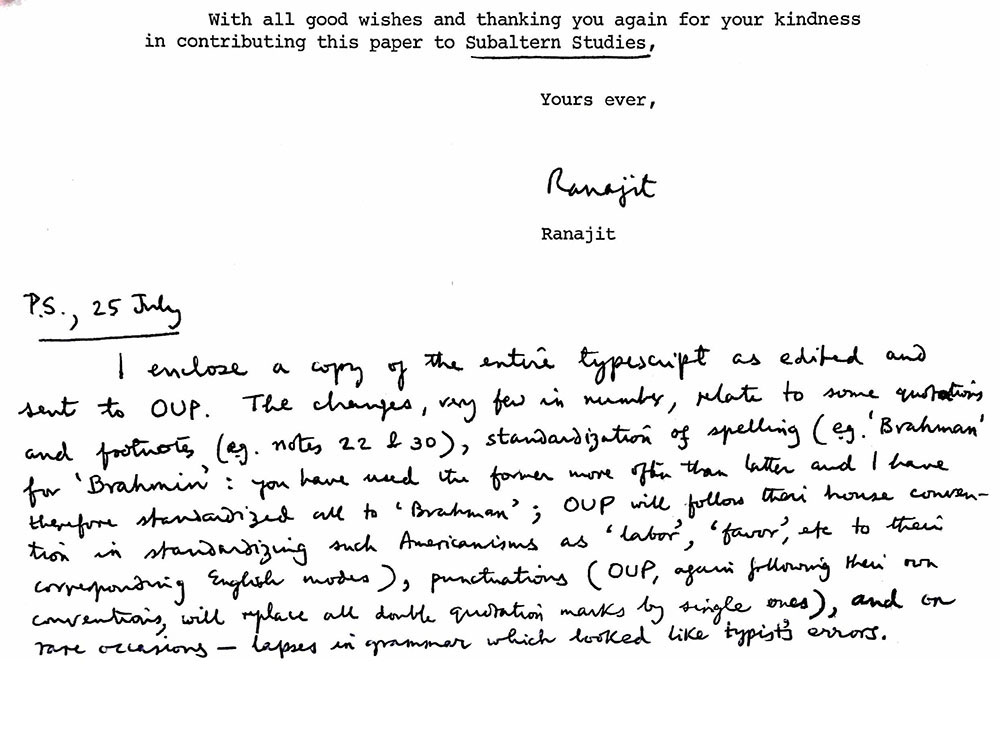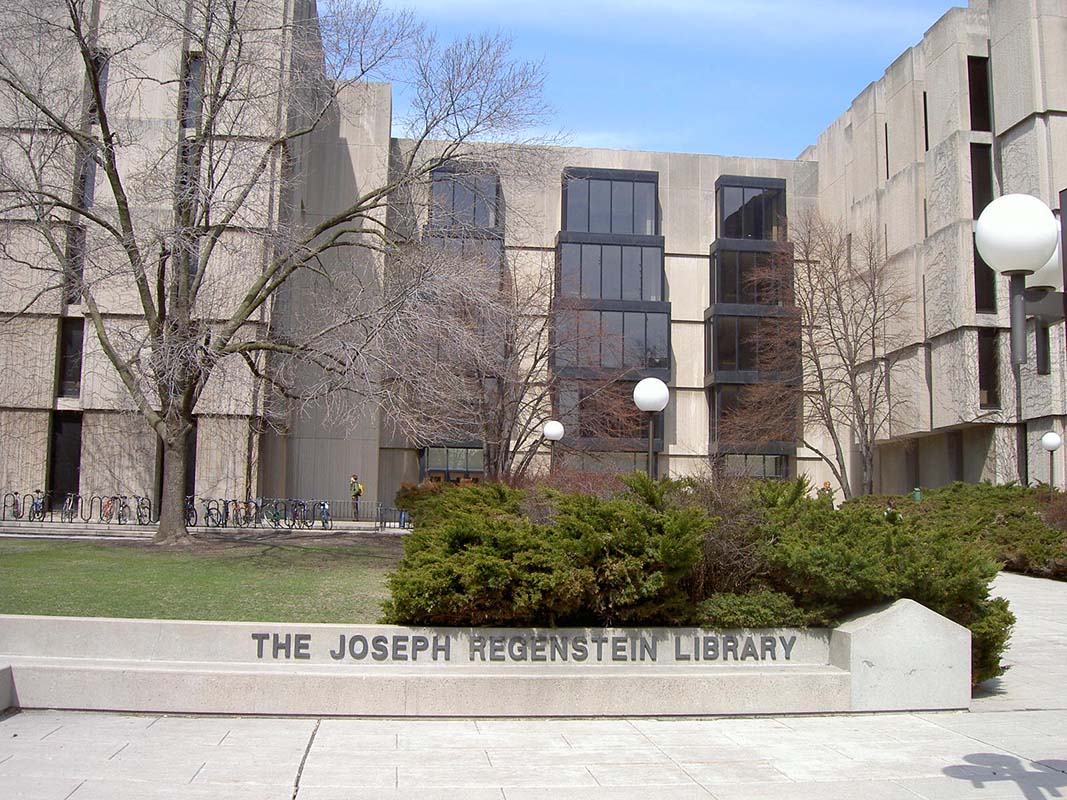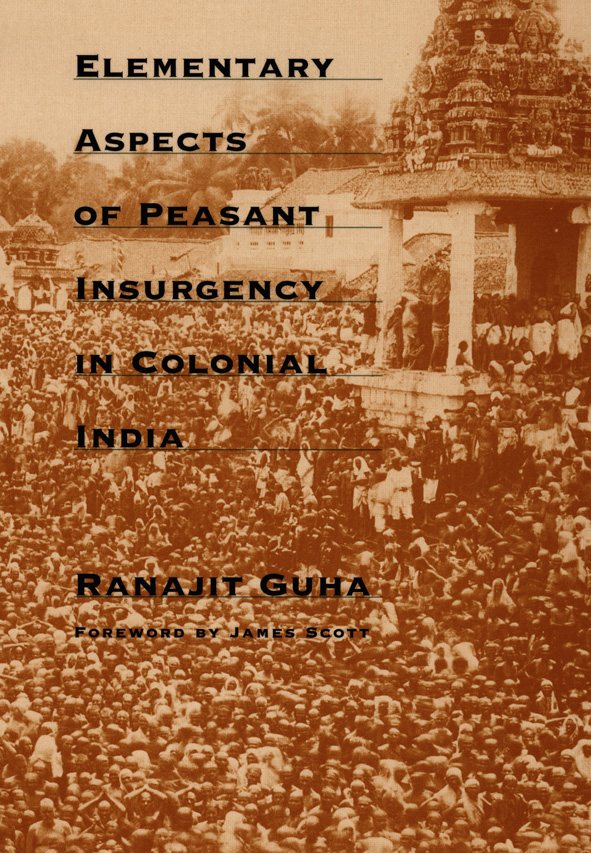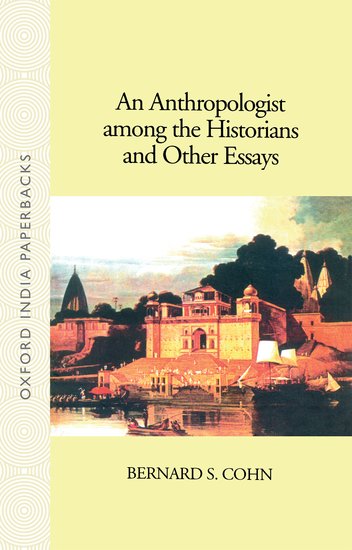Prequel to an Introduction: Ranajit Writes to Barney
The passing of Ranajit Guha on April 28, 2023 has led to a variety of discussions not only on the life and works of Guha but also on his location among a global community of academicians in the twentieth century. Some of the striking aspects of Guha’s intellectual career were his interest in questions that transcended disciplines; his method, which required a broader understanding of what constitutes the writing of history; and his collaborations with fellow scholars from distant parts of the world. This intellectual cosmopolitanism of Guha is reflected in the diverse places and individuals with whom Guha interacted and worked in his lifetime. Born in what was then East Bengal (now in Bangladesh), Guha grew up in Calcutta, spending long stretches of time in Manchester and Sussex before moving to Canberra and then finally settling down in Vienna. 1
Bernard Cohn (1928-2003) spent most of his career at the Department of Anthropology in the University of Chicago. Famous for works such as India: A Social Anthropology of a Civilization (1971) and Colonialism and its Forms of Knowledge: The British in India (1996), Cohn’s method too was distinctively interdisciplinary. It is then of no surprise that Ranajit Guha and Bernard Cohn formed a longstanding intellectual friendship, one that led to significant contributions in the study of Indian societies. Ranajit Guha’s appreciation for Bernard Cohn is, of course, evident from the former’s introduction to Cohn’s 1987 collection of writings in An Anthropologist among the Historians and Other Essays (Delhi: Oxford University Press). 2 However, a little-known collection of letters written by Guha to Cohn in the 1980s – presently held by the Joseph Regenstein Library at the University of Chicago – lends deeper understanding on a significant time of academic collaboration, interpersonal collegiality, and anxieties of meeting publishing deadlines in the days before the internet. The 80s were a particularly interesting time for both Guha and Cohn. While Guha launched the much-feted Subaltern Studies school during this time, a closer look at the Bernard Cohn papers (also at the University of Chicago Library) would suggest that Cohn was writing papers such as “History and Anthropology: Towards a Rapprochement?” in 1980. The letters mark this transitory moment in the lives of both scholars.

Fig. 1: Handwritten postscript to a letter written from Ranajit Guha to Bernard Cohn. (Courtesy of the Joseph Regenstein Library at the University of Chicago)
The first of the seven letters, written on 24 November 1981, carries Guha’s signature flair as he starts: “I apologise for not replying earlier to your very kind (though belated in its own turn) letter.” Two events from Guha’s intellectual life form the core of the letter. First, an upbeat Guha informs Cohn that he has sent the final manuscript of Elementary Aspects of Peasant Insurgency in Colonial India to Oxford University Press and does not see himself writing such a lengthy work in the foreseeable future. Significantly, to Guha, this project was more a way of opening up the field rather than of having the last word on it. He says that he wished to follow this monograph with essays that would continue to focus on “the problem of power in peasant insurgency.” Second, he mentions life at the Australian National University (ANU), where he was researching and teaching at that time. Apart from the anthropologist Roger Keesing, Guha was mostly disappointed by the academic output from departments such as History, Political Science, Economics (“Stone-Age mentality”), and international relations. However, he was almost ecstatic in his appreciation for the working conditions at the university. The university, he writes, provided him with a great opportunity to focus on his research and writing.

Fig. 2: Letter written from Ranajit Guha to Bernard Cohn in November 1981. (Courtesy of the Joseph Regenstein Library at the University of Chicago)
Guha writes the next letter on 1 April 1982, after returning from India following the publication of the first volume of Subaltern Studies. Content with the discussion that the volume had generated (despite criticisms from the “neo-colonialist and left-nationalist” circles), Guha invited Cohn to a conference on “The Subaltern in South Asian History” to be held at ANU on 26-28 November, 1982. Cohn’s popularity among the young subalterns was evident: “I expect there will be a stampede among people offering to put you up.” Guha left it to Cohn to grace the occasion in any capacity that the latter saw fit. The letter also highlights Guha’s involvement with the work of the young scholars. Guha, of course, is famous for mentoring and collaborating with a group of researchers back in the 1980s. Many of them – Partha Chatterjee, Dipesh Chakrabarty, and Shahid Amin, to name a few 3 - went on to have spectacular career trajectories and have made striking contributions to our understanding of history, political theory, and everyday society. Guha’s excitement with the range of work coming out of Calcutta and Delhi, and with the “general level of sophistication” among many researchers in their early 30s, is palpable in its effusiveness.
The next letter from the archive comes two years later, written on 27 April 1984, at a time when Subaltern Studies III was about to be published. Performing the role of an editor, Guha requests Cohn to contribute to Subaltern Studies IV and submit his chapter by the end of August. The immense faith that Guha placed in Cohn’s academic prowess is evident from his readiness to send Cohn’s chapter to the editors without any revision. He writes that “on no account shall I agree to the publication of this volume without a contribution under your signature.” As we know by now, this would turn out to be Cohn’s much celebrated article, “The Command of Language and the Language of Command.”

Fig. 3: The Joseph Regenstein Library at the University of Chicago, which houses the correspondence between Ranajit Guha and Bernard Cohn. (Photo courtesy of Wikimedia Commons user Americanist, 2008)
The letter that Guha writes to Cohn on 14 June 1985 is primarily concerned with the perpetual precarity of an academic career. Planning his life after retirement from ANU, Guha is of two minds: on the one hand, he considers applying to US institutions that Cohn has suggested; on the other hand, he entertains the possibilities of an extended stay at ANU. Meanwhile, he has read and admired Cohn’s article “The Peoples of India,” which he says “bristles with ideas.” An agitated Guha sends the next letter on 24 July 1985, mentioning how he was “suffering from editor’s nerves” but has nonetheless enjoyed Cohn’s article for Subaltern Studies IV (the publication of which was clearly delayed by a few months since the April ’84 letter). Describing it as “nearly perfect,” Guha acknowledges the lucidity of the argument and the handling of the evidence, going so far as to claim that nothing like it exists in the literature on modern Indian history. Guha was evidently agitated less about the quality of writing than he was about the logistics of mediating between the authors and publishers. A chance visit by the famous historian Sumit Sarkar to Canberra at that time eased his anxieties somewhat. Cohn’s article was delivered to Oxford University Press through Sarkar, thus completing the elaborate US-Australia-India academic circuit. The letter ends with two paragraphs of postscript in Guha’s handwriting, informing Cohn about a few formal changes he has made to the latter’s article.

Fig. 4: Ranajit Guha’s Elementary Aspects of Peasant Insurgency in Colonial India. (Cover image courtesy of Duke University Press)
The next letter – from 13 March 1986 – carried with it a hint of sadness on three counts. Guha wishes Cohn’s partner Rella a speedy recovery. He was also disappointed with Cohn’s inability to come to India for a conference due to visa-related complications. Finally, he lamented the lack of academic focus in the conference – the second edition of the one held previously in Canberra. The many voices in the event, to him, led to little more than noise. Interestingly, Guha goes a step further and embraces the chaotic nature of such congregations. He says that it is “in the very nature of the development of our project.” By this time, four volumes of Subaltern Studies had been published. On a fundamental level, the group aimed at making history polyphonic, accessible, and democratic. It sought to do away with privileging a particular kind of (colonial) archive and to write histories based on silenced voices of the peasants and lower castes, oral traditions, and Indigenous beliefs. Being at the helm of a school of thought based on the spirit of inclusivity, Guha possibly saw meaning in reconciling with a certain lack of structure. If decentering was one of the watchwords of the Subaltern Studies Collective, it only follows that it would not suit its followers to discipline and curate voices according to their wishes, even if it led to a certain amount of disorder.

Fig. 5: Bernard Cohn’s An Anthropologist Among the Historians and Other Essays. (Cover image courtesy of Oxford University Press)
The final letter from 2 October 1986 brings us back to the aforementioned introduction that Guha penned for Cohn’s 1987 book. Visibly moved by Cohn’s body of work, Guha acknowledges the challenge he faced while analyzing the scholarly contribution of someone with whom he shares much intellectual attachment. A telling paragraph on intertextuality leads Guha to deliberate on the influence of past texts in the writing of a new one. Citing Marx’s unconscious “borrowing” of Hegel, Guha finds it least surprising that the same has happened with Kroeber’s influence on Cohn. (Guha discusses this at length in the introduction itself.) Replacing the term ‘influence’ with ‘catalysis,’ Guha refers to a broader knowledge system whereby present and future research is always already indebted to an extant body of work that has a firm hold on their discipline of study. In any case, Guha was quite eager to see An Anthropologist among the Historians and Other Essays in print: “please hurry up with the proofs.” Simultaneously, work went on as usual for him. He shared with Cohn the progress on his latest research on the structure of politics in colonial India.
The slice of interaction between two academic giants captured in these few letters speaks of a particular time in the study of South Asia. It was a period marked by excitement at a birth of a new school, as well as by print culture consisting of telex communications and essays sent by hand for publication. It was also an era marked by intellectual camaraderie across – but not limited to – Canberra, Chicago, New Delhi, and Calcutta. 4
Titas De Sarkar is a PhD Scholar in South Asian Languages and Civilizations at The University of Chicago. Email: titas@uchicago.edu